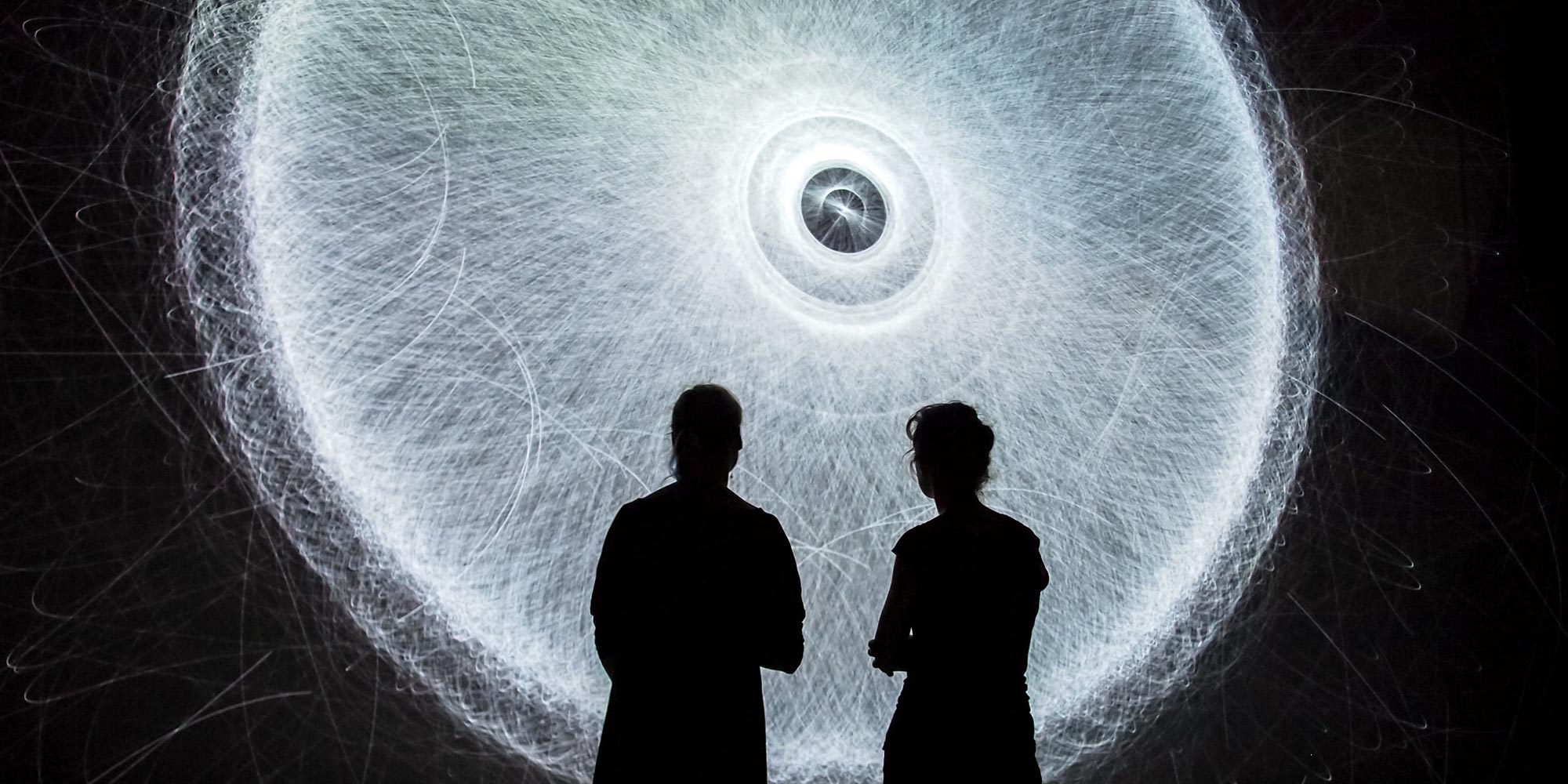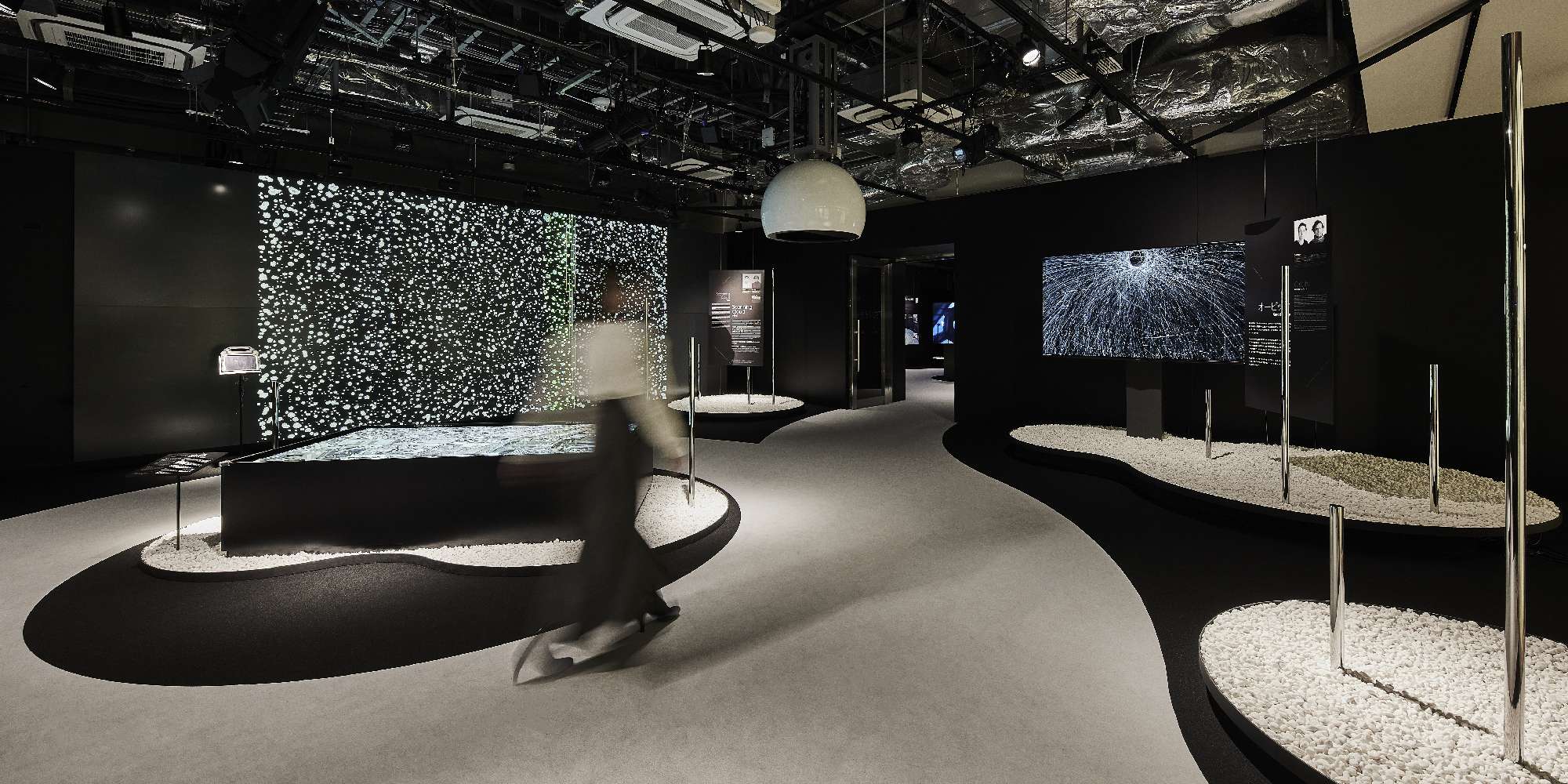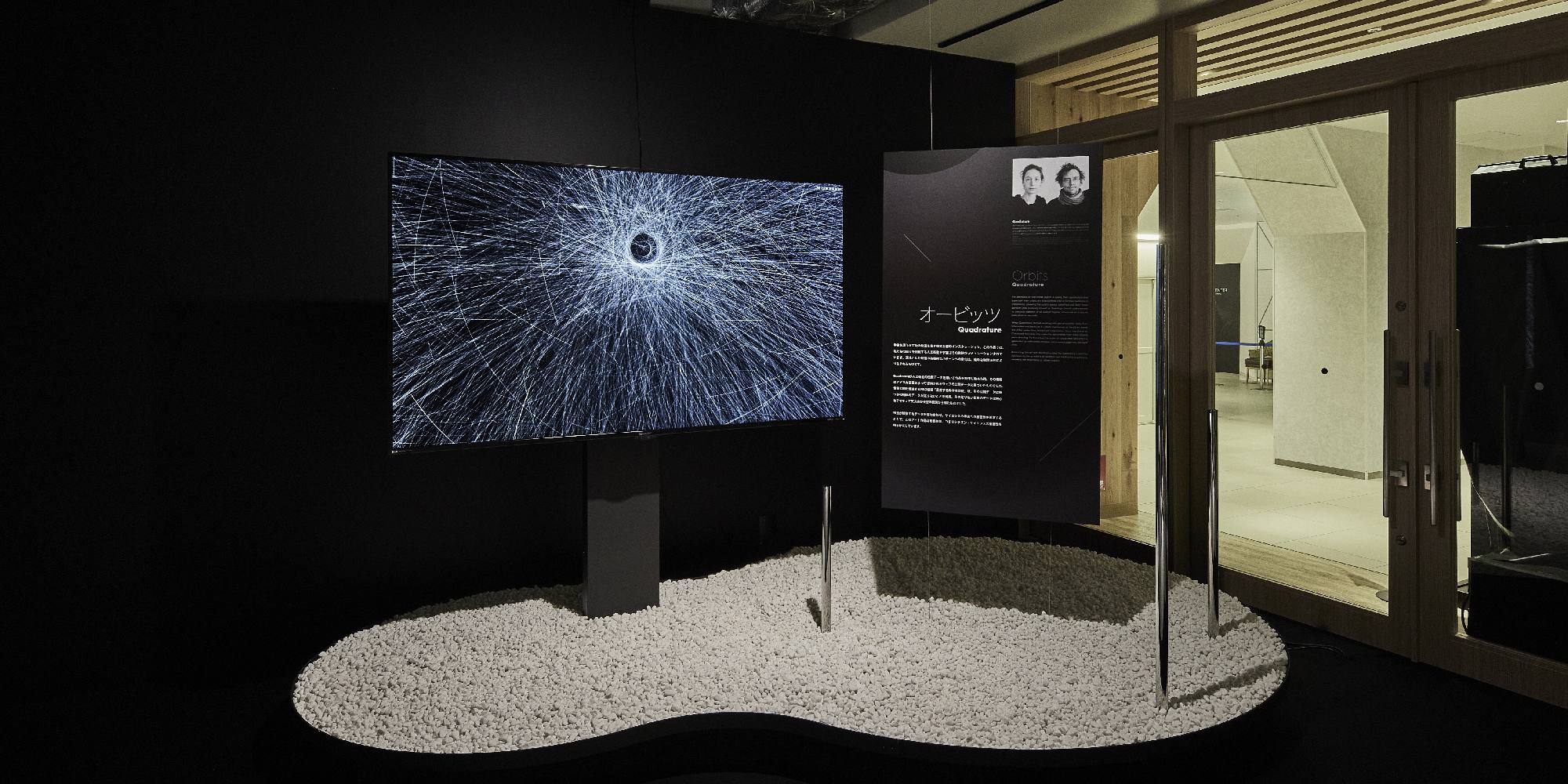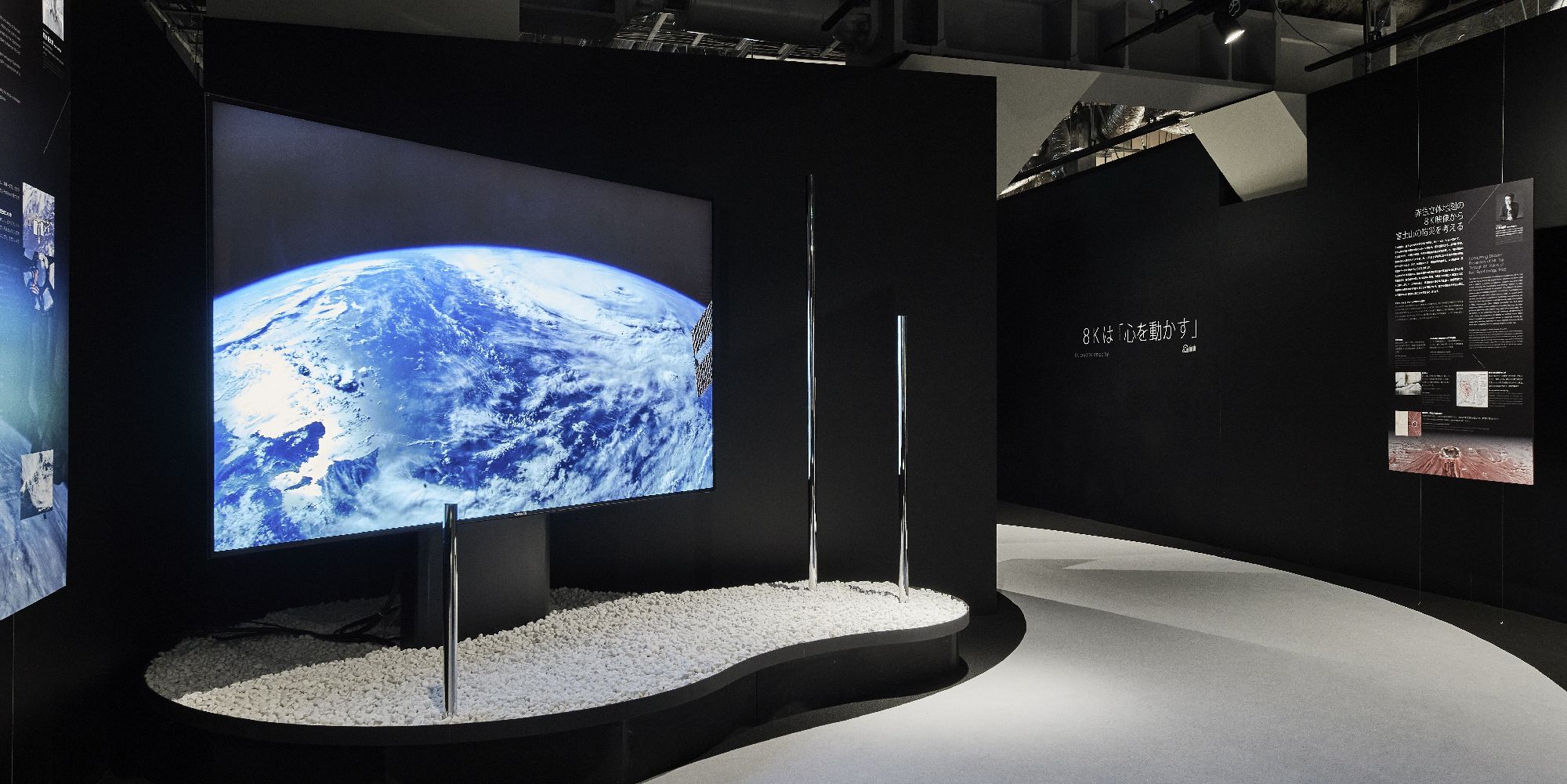„Resonant Media – Possibilities of 8K Visualization“ verfolgte einen künstlerischen und wissenschaftlichen Ansatz, um die neuen Möglichkeiten von 8K aus verschiedenen Perspektiven zu erkunden. Die Ausstellung in Tokio im Jahr 2021 präsentierte eine Vielzahl von Projekten, die die Zukunft von 8K über den bestehenden Rahmen hinaus erforschten.
„Resonant Media“ war Teil der Kollaboration Beyond the Frame – 8K Future Projects zwischen Japans größter öffentlich-rechtlicher Rundfunkanstalt NHK and dem Ars Electronica Futurelab. Die Ausstellung in Shibuya, Tokio, fand vom 14. bis zum 31. März 2021 statt.
Resonant Media – Possibilities of 8K Visualization: Eindrücke von der Ausstellung in Tokio; Video: NHK
Seit 2018 konzentrierte sich die Zusammenarbeit zwischen Ars Electronica Futurelab und NHK auf die Entwicklung mehrerer Schlüsselszenarien, die die Zukunft der nächsten Generation der UHDTV-Technologie 8K untersuchen. Verschiedene Anwendungen von 8K-Inhalten wurden anhand von Fragen der Bildkomposition und neuen Formen der Inszenierung untersucht. Das Team entwickelte und testete verschiedene Szenarien für Beyond the Frame – 8K Future Projects and Cascade.
Hochauflösende Einblicke in die Forschung zu den Möglichkeiten der UHDTV-Technologie 8K waren Thema der zukunftsweisenden Ausstellung „Resonant Media – Possibilities of 8K Visualization“, die mit vielen innovativen Wegen experimentierte, die Spitzentechnologie in einen zunehmend digitalisierten Alltag zu integrieren. Gemeinsam mit NHK erforschte das Ars Electronica Futurelab neue Formate, innovative Interaktionsmethoden und experimentelle Settings, die die Wahrnehmung in der 8K-Welt beeinflussen.
Für die Ausstellung wählten das Ars Electronica Futurelab und NHK verschiedene künstlerisch-wissenschaftliche Ansätze aus, die mit der 8K-Technologie in Verbindung stehen. Die Besucher*innen wurden eingeladen, die Ausstellung zu betreten und die Welt von 8K mit zwei virtuellen Guides zu erkunden, die auf zwei vertikal angeordneten Bildschirmen am Eingang präsentiert wurden. Der 8K Cascade Guide war ein Ausstellungsführer, der zwei Forschungsprojekte von NHK und Ars Electronica Futurelab kombinierte: 8K Lifescale, das Medieninhalte in Lebensgröße darstellte, und 8K Cascade, das Medieninhalte in vertikalem Format präsentierte. Die vertikale Kommunikation in Lebensgröße ermöglicht realistischere Dialoge und eine stärkere emotionale Bindung.
Im ersten Ausstellungsraum präsentierte das Berliner Künstler*innen-Duo Quadrature (DE) die Arbeit „Orbits“. Die Ästhetik von künstlichen Objekten im Weltraum, ihr Aussehen und insbesondere ihre Umlaufbahnen werden in eine minimalistische audiovisuelle Installation verwandelt, die den poetischen Tanz der Satelliten und ihres Weltraumschrotts zeigt, während sie um uns kreisen. Scheinbar chaotische Bahnen verwandeln sich in erstaunliche Muster von fast organischer Natur – alles aufgrund rein physikalischer Notwendigkeit. Offizielle Satellitendaten, ergänzt durch Daten von Amateurastronom*innen, bilden die visuelle Grundlage für diese ästhetische Begegnung, die eine verborgene Ebene der menschlichen Infrastruktur erforscht.
„Scanning Cloud“ der Designergruppe vØid (JP) zeigte auf einer großen Leinwand einen Schwarm aus winzigen Körnern, die sich organisch zusammen- und wieder auseinanderziehen. Diese mikroskopische Welt wird durch Scanlinien erfasst, nimmt Farbe an und gibt Töne von sich. Durch die räumliche Wahrnehmung dieses Modells und den Klang kann sie erlebt werden. Mit einem tragbaren Gerät können die Betrachter*inen die Bewegungen der mikroskopisch kleinen Körner steuern. Durch dieses Modell und den Klang ist es möglich, die Natur der Welt eines riesigen Schwarms zu erleben und zu manipulieren.
„Hakoniwa – Tokyo from Above“ von NHK Technologies (JP) ermöglichte es den Zuschauer*innen, die dynamische Schönheit der Stadt als bewegtes Hakoniwa – ein in Japan beliebter Miniaturgarten in einer Box – zu erleben, indem sie die Landschaft Tokios aus der Vogelperspektive in 8K betrachten konnten.
Im zweiten Ausstellungsraum bildeten zwei Installationen einen Dialog zwischen Kunst und Wissenschaft, die beide auf Daten der Internationalen Raumstation (ISS) basierten. „Machine Hallucinations – ISS Dreams“ des Medienkünstlers und Regisseurs Refik Anadol (TR/US) verwandelt einen riesigen Datensatz von 1,2 Millionen Bildern, die von der Internationalen Raumstation (ISS) aufgenommen wurden, zusammen mit zusätzlichen Satellitenbildern der Topologie der Erde in ein dynamisches Datenbild.
Gegenüber dieser Installation zeigte „A Typhoon Seen From ISS“ des Forschers Araki Kentaro (JP) 8K-Bilder des Taifuns Nr. 10 vom September 2020, aufgenommen von der Internationalen Raumstation. Die 8K-Kamera an Bord der ISS ermöglicht es, Videos der Erde in noch realistischeren Details aufzunehmen. Im Gegensatz zu Bildern von Wettersatelliten kann man die sogenannte „Multiple-Eye-Struktur“ beobachten, bei der sich Wolken an einer Stelle nahe des Auges eines Taifuns verdichten.
Die interaktive Installation „World’s First 8K Moving Image of Cell Destruction Caused by New Coronavirus Infection“ von Associate Professor Emi Nakayama (JP) ermöglichte es den Betrachtenden, die Details des Prozesses zu beobachten, durch den das Virus infizierte Zellen zerstört. Die Beobachtung von Zellen mit einem weiten Sichtfeld mittels ultrahochauflösender 8K-Videos verspricht nicht nur neue Erkenntnisse über Virusinfektionen, sondern auch in Bereichen wie dem Verhalten von Krebszellen und der Apoptose.
„Considering Disaster Prevention of Mt. Fuji Through 8K Video of Red Relief Image Map“ von Forscher Chiba Tatsuro (JP) ist eine CG-Simulation, die die Topografie des aktiven Vulkans Fuji in 3D visualisiert. So können auch Lai*innen die Topologie und Höhe intuitiv erkennen und konkretere Maßnahmen zur Vorbereitung auf einen Vulkanausbruch des Fuji werden möglich.
„The Global Spread of the Coronavirus 8K Visualization of Big Data“ von Yamabe Masaki and Nakagawa So (JP) stellt Big Data des mutierten Virus in 8K mit NMAPS dar, einem von NHK entwickelten Visualisierungssystem. Die Ausstellung zeigt, wann und wo Varianten des Virus entdeckt wurden. Durch das Ausfüllen einer Karte im Laufe der Zeit wird der Übertragungsweg des Virus sichtbar. Da komplexe, detaillierte Phänomene mit einem weiten Blickfeld betrachtet werden können, soll dieses Tool Fachleuten dabei helfen, Diskussionen zu führen und neue Entdeckungen zu machen.
Die Ausstellung endete mit „Resonant Memory“, einer visuellen und akustischen Installation der Videoregisseurin / Redakteurin Takahashi Rikako (JP), die gemeinsam von NHK und Ars Electronica Futurelab zum 10. Jahrestag des großen Erdbebens in Ostjapan realisiert wurde. Mit Hilfe der 8K-Technologie vermittelt die Installation die Erinnerungen der Menschen an das Erdbeben und zeigt Bilder der Region, um eine Geschichte des Wiederaufbaus und der Hoffnung für die Zukunft zu erzählen. Die Installation zeigt, wie sich Natur und Gesellschaft von den Zerstörungen durch das Erdbeben erholen und wie die Menschen in der Katastrophe zusammenkamen, um sich gegenseitig zu helfen und zu unterstützen. Das Erleben der Erinnerungen der Natur und der Menschen im 8K-Raum mit seinen feinen Details schafft eine emotionale Verbindung, als wäre man selbst mit dieser Person dort gewesen. Die sich überlagernden Panoramen von Tokio und den Katastrophengebieten symbolisieren Zerstörung und Wiederaufbau, und die Skala der Uhr den Verlauf von zehn Jahren. Die Installation hilft uns, die Solidarität der Menschen und die Kraft der Natur und der Gesellschaft als eine prägende Erinnerung für die Zukunft zu bewahren.
Inside Futurelab: NHK meets Ars Electronica Futurelab – Resonant Media
Als Alternative zum Besuch der Ausstellung vor Ort in Tokio strahlte Ars Electronica Home Delivery eine virtuelle Führung aus, die Einblicke in die Ausstellung gab. Nach der Präsentation verschiedener künstlerisch-wissenschaftlicher Ansätze diskutierten geladene Experten in einer Podiumsdiskussion im Deep Space 8K über die Bedeutung von 8K.
Mehr zur Zusammenarbeit mit NHK und der „Resonant Media“-Ausstellung gibt’s im Interview with Nicolas Naveau im Ars Electronica Blog.
Credits
Ars Electronica Futurelab: Nicolas Naveau, Yoko Shimizu, Hideaki Ogawa, Peter Freudling
Partner: NHK







